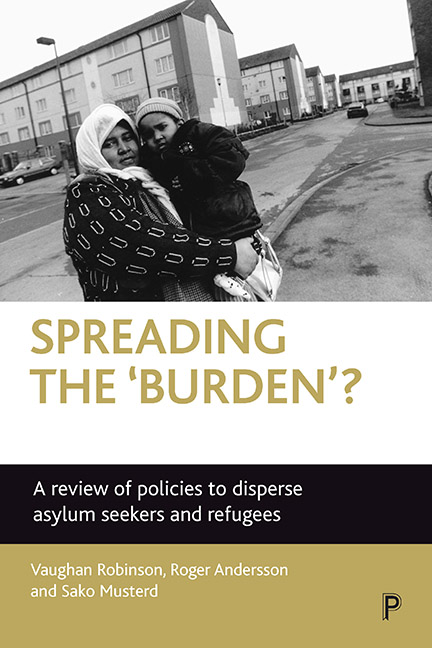Book contents
- Frontmatter
- Contents
- List of tables and figures
- Acknowledgements
- Glossary
- one Introduction
- two Defining the ‘problem’
- three Dispersal policies in the Netherlands
- four Dispersal policies in Sweden
- five Dispersal policies in the UK
- six What works? Improving the efficiency and effectiveness of dispersal
- seven Redefining the ‘problem’ and challenging the assumptions
- References
- Index
- Also available from The Policy Press
five - Dispersal policies in the UK
Published online by Cambridge University Press: 20 January 2022
- Frontmatter
- Contents
- List of tables and figures
- Acknowledgements
- Glossary
- one Introduction
- two Defining the ‘problem’
- three Dispersal policies in the Netherlands
- four Dispersal policies in Sweden
- five Dispersal policies in the UK
- six What works? Improving the efficiency and effectiveness of dispersal
- seven Redefining the ‘problem’ and challenging the assumptions
- References
- Index
- Also available from The Policy Press
Summary
Immigration to Britain: the long view
The continual ebb and flow of migration has forged the British nation. While millions of Britons left the UK to colonise the New World, 500,000 Irish men and women arrived in England and Wales between 1800 and 1851. As British administrators, merchants and soldiers left for India and the West Indies, so Indian nannies, princes and seamen headed for Britain (Visram, 2002), alongside black African slaves, who numbered some 20,000 in London alone by 1764 (Walvin, 1984). And people did not simply come and go for work; rather, Britain developed a reputation prior to the 20th century as a place of refuge. In the last years of the 17th century, as many as 50,000 French Huguenots fled to London. And from 1881 onwards, Eastern European Jews began arriving in large numbers to escape the pogroms in the Pale of Settlement. As a result, by the turn of the 20th century, only the US had resettled more Eastern European Jews than England. While the 1905 Aliens Act effectively ended that particular migration, other voluntary and involuntary migrants continued to arrive in the UK in sizeable numbers: Chinese seamen settled in the major ports (Watson, 1977; Peach and Robinson, 1988); 60,000 middle-class Jews fled Nazi Germany and took up residence in the UK between 1933 and 1939; and around 250,000 Italians migrated to the UK between 1861 and 1991 – the earliest migrants walked from the valleys of northern Italy.
However, it was the migrations linked to the long economic boom of the postwar period that generated perhaps the greatest social impact. In the immediate aftermath of the Second World War, Britain was a spent force, heavily burdened with debt, ravaged by war-time destruction, living off Victorian infrastructure, and fading in global political and military significance. Her continued competitiveness and economic health depended greatly upon the speed and scale of postwar reconstruction. Central to this task was the need for labour. Initially, Britain turned to Ireland for workers, but this source proved inadequate. The government had to look further afield, notably towards the displaced persons of continental Europe and the exiled communities that had sought temporary sanctuary in the UK during the war. In total, some 100,000 Irish workers entered Britain between 1946 and 1951, and the number had swelled further to 352,000 by 1959 (Walvin, 1984).
- Type
- Chapter
- Information
- Spreading the 'Burden'?A Review of Policies to Disperse Asylum Seekers and Refugees, pp. 103 - 148Publisher: Bristol University PressPrint publication year: 2003



